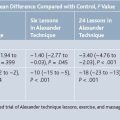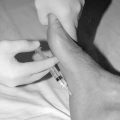1 Fundamentals of Procedural Care
Procedure Planning
The patient work-up should begin with a detailed history and a physical examination that focuses on the body part involved. Historical emphasis on the duration of symptoms, previous attempts at procedures, and pending litigation should be well documented. Signs of symptoms magnification and malingering should be noted.1,2
General Procedure Techniques
Skin Preparation
Because skin cannot be sterilized without damage, the goal of antiseptics is to remove transient and pathogenic microorganisms while reducing resident flora to a low level.3 These agents should be safe, rapid-acting, inexpensive, and effective on a broad spectrum of organisms.3,4 Multiple agents, including iodophors (Betadine), hexachlorophene (pHisoHex), chlorhexidine (Hibiclens, Hibitane), and alcohols, are commercially available and accomplish these desired goals.3,5–7
The preferred agent remains controversial.3,8–13 Clinically, the most commonly used agents are alcohol and iodine, with the latter being superior for skin decontamination.16 Application of 70% isopropyl alcohol destroys 90% of the cutaneous bacteria in 2 minutes, whereas the usual single wipe without waiting procedure destroys, at most, 75% of cutaneous bacteria.3
Skin regions with hair should not alter one’s method of skin decontamination. Hair removal by shaving increases wound infection rate and is contraindicated.17–19 If absolutely necessary, clipping hair20,21 or applying depilatory creams19 can be safe.22 The overall risk of wound infection with most pain procedures is low and mostly depends on the technique that the practitioner employs during the procedure.
Needle Insertion and Local Anesthesia
Steps should be taken to make all procedures as pain-free as possible. The liberal use of local anesthetics in adequate concentrations will promote this goal while minimizing repeat needle sticks. Small diameter needles, 28 to 30 gauge, are initially used to anesthetize the skin and subcutaneous tissue. Distracting the skin with one’s fingers while slowly advancing the needle helps to reduce pain. The tip of the needle can be placed in the subcutaneous fat and, upon injection, less pain is noted than with intradermal injections because of the distensibility of fat. Rapid infusion of medication, especially with large volumes, causes tissue distention and results in pain. Lidocaine23–26 and bupivacaine,27 buffered with 8.4% sodium bicarbonate causes less pain than plain anesthetics and is equally efficacious. A 1:10 to 1:20 ratio of sodium bicarbonate to anesthetics can be used. Morris and colleagues found that, when injected, subcutaneous procaine and lidocaine were the least painful anesthetics.28,29 Only etidocaine was found to be more painful than bupivacaine. Varelmann and coworkers found that patients who were told “We are going to give you a local anesthetic that will numb the area and you will be comfortable during the procedure” perceived less pain than patients who were told “You are going to feel a big bee sting; this is the worst part of the procedure.”30
Other preparations used to reduce pain with initial needle injections include topical anesthetics (eutectic mixtures of local anesthetics, or EMLA), vapocoolant sprays, and preheated local anesthetics.31 If the patient is intolerant of or allergic to anesthetic agents, 0.9% intradermal saline or dilute antihistamines such as diphenhydramine (Benadryl) in 10 to 25 mg/mL injections can be used as alternatives;32 however, they are often considered painful, especially when injected intradermally.
Precautions
Good technique not only reduces the risk of wound infection, but also lowers the rate of viral transmission between patient and physician. Physicians who perform exposure-prone procedures should know their own human immunodeficiency virus (HIV) and hepatitis B virus (HBV) antibody status. The risk to the patient of contracting the HIV virus ranges from 1 in 42,000 to 1 in 420,000; the risk of contracting fatal HBV infection from an HBeAg positive surgeon during a procedure ranges from 1 in 76,000 to 1 in 1.4 million.33 Universal precautions should be understood and include the use of gloves, protective eyewear, masks, (optional), and gowns (optional). Recapping used needles should be avoided and is seldom necessary.
1. Becker G.E. Red Flags. Oakland, Calif: American Back Society Newsletter; 1991. p 23
2. Carragee E.J. Psychological and functional profiles in select subjects with low back pain. Spine J. 2001;1(3):198-204.
3 Sebben J.E. Surgical antiseptics. J Am Acad Dermatol. 1983;9:759-765.
4. Masterson B.J. Skin preparation. Clin Obstet Gynecol. 1988;31:736-743.
5. Davies J., Babb J.R., Ayliffe G.A., Wilkins M.D. Disinfection of skin of the abdomen. Br J Surg. 1979;65:855-858.
6. Lepor N.E., Madyoon H. Antiseptic skin agents for percutaneous procedures. Rev Cardiovasc Med. 2009;10(4):187-193.
7. Ritter M.A., French M.L., Eitzen H.E., et al. The antimicrobial effectiveness of operative-site preparative agents: a microbiological and clinical study. J Bone Joint Surg Am. 1980;62:826-828.
8. Bibbo C., Patel D.V., Gehrmann R.M., Lin S.S. Chlorhexidine provides superior skin decontamination in foot and ankle surgery: A prospective randomized study. Clin Orthop Relat Res. 2005;438:204-208.
9. Calfee D.P., Farr B.M. Comparison of four antiseptic preparations for skin in the prevention of contamination of percutaneously drawn blood cultures: A randomized trial. J Clin Microbiol. 2002;40(5):1660-1665.
10. Kiyoyama T., Tokuda Y., Shiiki S., et al. Isopropyl alcohol compared with isopropyl alcohol plus povidone-iodine as skin preparation for prevention of blood culture contamination. J Clin Microbiol. 2009;47(1):54-58.
11. Lowbury E.J., Lilly H.A. Use of 4% chlorhexidine detergent solution (Hibiscrub) and other methods of skin disinfection. Br Med J. 1973;1:510-515.
12. Saltzman M.D., Nuber G.W., Gryzlo S.M., et al. Efficacy of surgical preparation solutions in shoulder surgery. J Bone Joint Surg Am. 2009 Aug;91(8):1949-1953.
13. Smylie H.G., Logie J.R., Smith G. From Phisohex to Hibiscrub. Br Med J. 1973;4:586-589.
14. Swenson B.R., Hedrick T.L., Metzger R., et al. Effects of preoperative skin preparation on postoperative wound infection rates: A prospective study of 3 skin preparation protocols. Infect Control Hosp Epidemiol. 2009 Oct;30(10):964-971.
15. Tunevall T.G. Procedures and experiences with preoperative skin preparation in Sweden. J Hosp Infect. 1988;11 (suppl B):11-14.
16. Choudhuri M., McQueen R., Inoue S., et al. Efficiency of skin sterilization for a venipuncture with the use of commercially available alcohol or iodine pads. Am J Infect Control. 1990;18:82-85.
17. Bird B.J., Chrisp D.B., Scrimgeour G., et al. Extensive pre-operative shaving: A costly exercise. N Z Med J. 1984;97:727-729.
18. Celik S.E., Kara A. Does shaving the incision site increase the infection rate after spinal surgery? Spine. 2007;32(15):1575-1577.
19. Seropian R., Reynolds B.M. Wound infections after preoperative depilatory versus razor preparation. Am J Surg. 1971;121:251-254.
20. Mackenzie I. Preoperative skin preparation and surgical outcome. J Hosp Infect. 1988;11:27-32.
21. Olson M.M., MacCallum J., McQuarrie D.G. Preoperative hair removal with clippers does not increase infection rate in clean surgical wounds. Surg Gynecol Obstet. 1986;162:181-182.
22. Tanner J., Moncaster K., Woodings D. Preoperative hair removal: A systematic review. J Perioper Pract. 2007;17(3)(118-121):124-132.
23. McKay W., Morris R., Mushlin P. Sodium bicarbonate attenuates pain on skin infiltration with lidocaine, with or without epinephrine. Anesth Analg. 1987;66:572-574.
24. Roberts J.R. Local anesthetics: Injection techniques. Emerg Med News. 1992 March:9-16.
25. Stewart J.H., Chinn S.E., Cole G.W., et al. Neutralized lidocaine with epinephrine for local anesthesia – II. J Dermatol Surg Oncol. 1990;16:842-845.
26. Xia Y., Chen E., Tibbits D.L., et al. Comparison of effects of lidocaine hydrochloride, buffered lidocaine, diphenhydramine, and normal saline after intradermal injection. J Clin Anesth. 2002;14(5):339-343.
27. Cheney P.R. Molzen G, Tandberg D: The effect of pH buffering on reducing the pain associated with subcutaneous infiltration of bupivicaine. Am J Emerg Med. 1991;9:147-148.
28. Morris R., McKay W., Mushlin P. Comparison of pain associated with intradermal and subcutaneous infiltration with various local anesthetic solutions. Anesth Analg. 1987;66:1180-1182.
29. Morris R.W., Whish D.K. A controlled trial of pain on skin infiltration with local anaesthetics. Anaesth Intensive Care. 1984;12:113-114.
30. Varelmann D., Pancaro C., Cappiello E.C., Camann W.R. Nocebo-induced hyperalgesia during local anesthetic injection. Anesth Analg. 2010;110(3):868-870.
31. Bloom L.H., Scheie H.G., Yanoff M. The warming of local anesthetic agents to decrase discomfort. Ophthalmic Surg. 1984;15:603.
32. Mark L.C. Avoiding the pain of venipuncture (letter to the editor). N Engl J Med. 1976;294:614.
33. Lo B., Steinbrook R. Health care workers infected with the human immunodeficiency virus. The next steps. JAMA. 1992;267:1100-1105.






